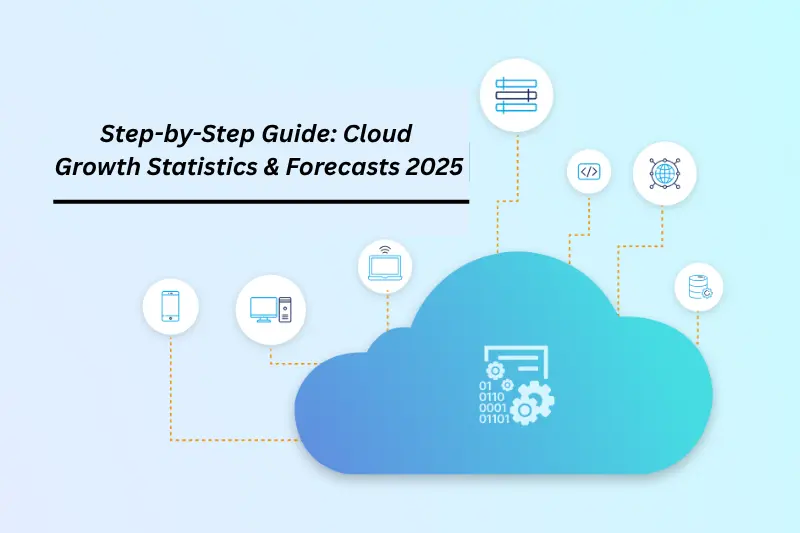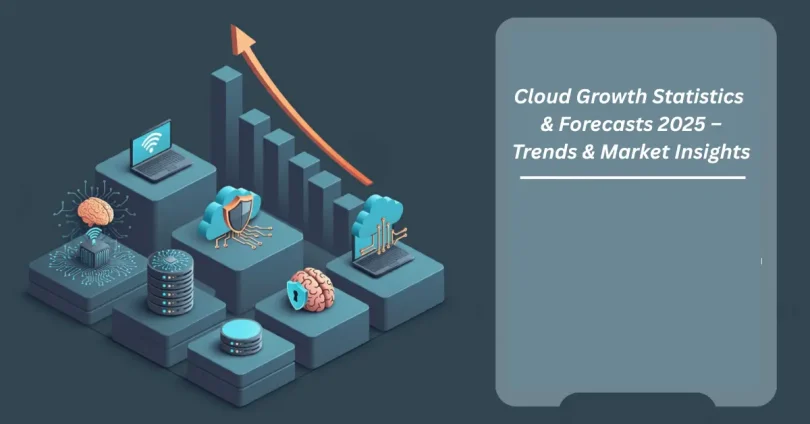Introduction
The cloud industry is growing faster than ever, and 2025 is proving to be a major turning point. Businesses of all sizes are investing more in cloud services to improve flexibility, reduce costs, and stay competitive in a digital-first world. In this blog, we’ll explore Cloud Growth Statistics & Forecasts 2025 – Trends & Market Insights to help you understand where the cloud market is headed, what’s driving this growth, and what it means for your business. Whether you’re a tech professional, business owner, or just curious about cloud computing, this guide will give you a clear and up-to-date view of the current cloud landscape.
What is Cloud Growth Statistics & Forecasts 2025?

Cloud Growth Statistics & Forecasts 2025 refer to the latest data, trends, and future predictions about how the cloud computing market is expanding this year and beyond. These statistics include numbers like how much businesses are spending on cloud services, how fast the market is growing, which industries are leading adoption, and which technologies (like AI, edge computing, or multi-cloud) are influencing growth.
Forecasts also show where the cloud market is heading—what we can expect in the next 5 to 10 years. This helps companies, developers, and IT leaders make smarter decisions based on real market trends.
In simple terms, this topic gives you a snapshot of the current state of cloud computing in 2025 and where it’s going next.
You may also like it:
Cloud Compliance Requirements – Ensure Secure & Lawful Cloud Operations
Securing Multi-Cloud Environments – Strategies for Safer & Smarter Cloud Protection
Top Cloud Security Tools 2025 – Protect Your Data with Trusted & Powerful Solutions
Why Understanding Cloud Growth Statistics & Forecasts 2025 is Important
Helps Businesses Plan for the Future
- Informed Investments
Knowing where cloud spending is rising helps businesses allocate budgets more wisely and avoid overspending. - Tech Adoption Strategy
Forecasts show which technologies will dominate, helping companies prioritize what to adopt next. - Scalability Planning
Understanding future cloud trends enables better planning for scaling operations smoothly.
Supports Competitive Advantage
- Stay Ahead of Rivals
Companies that follow cloud trends can adopt faster and stay ahead of slower-moving competitors. - Boosts Innovation
Access to current statistics helps teams innovate by adopting trending cloud solutions. - Improves Customer Experience
Using cloud insights, businesses can offer faster, more reliable digital services.
Guides IT and Cloud Professionals
- Better Career Planning
Cloud professionals can align their skills with future technologies in demand. - Improves Decision-Making
Data-driven forecasts help IT leaders choose the right vendors and platforms. - Supports Cloud Migration Goals
Stats provide clarity on the best time and strategy to move systems to the cloud.
Benefits Investors and Analysts
- Market Growth Visibility
Investors can identify high-growth cloud sectors and make smart funding choices. - Track Tech Giants’ Performance
Forecasts highlight how providers like AWS, Azure, and GCP are performing in 2025. - Spot Emerging Startups
Data reveals which new players are gaining traction in the cloud market.
Step-by-Step Guide: Cloud Growth Statistics & Forecasts 2025

Step 1: Understand the Basics of Cloud Computing
- Before diving into stats, know what cloud computing is—storing and accessing data and services over the internet instead of local servers.
- Learn about the main types: public cloud, private cloud, hybrid, and multi-cloud.
Step 2: Identify the Key Cloud Market Segments
- Explore the main segments such as Infrastructure as a Service (IaaS), Platform as a Service (PaaS), and Software as a Service (SaaS).
- Check how each segment is performing in 2025 and which industries are adopting them fastest.
Step 3: Review the Latest Market Reports and Data
- Use reliable sources like Gartner, IDC, Statista, and industry whitepapers to find 2025 stats.
- Look for data on spending, growth rates, cloud usage, and regional adoption.
Step 4: Analyze Growth Drivers Behind Cloud Expansion
- Understand what’s fueling growth—AI integration, edge computing, remote work, and demand for scalability.
- See which technologies are pushing companies to move more of their infrastructure to the cloud.
Step 5: Study Regional and Industry-Specific Trends
- Break down the data by region (e.g., North America, Europe, Asia-Pacific) and industry (healthcare, finance, retail, etc.).
- This helps understand how adoption varies and where the biggest opportunities lie.
Step 6: Explore Market Forecasts for the Next 5–10 Years
- Look at projections for 2026–2030 to see how the market is expected to evolve.
- Check forecasts for cloud spending, adoption rates, and emerging tech trends.
Step 7: Use Insights to Guide Strategy or Investment
- Apply the data to your business strategy—whether it’s migrating workloads, investing in cloud training, or choosing a vendor.
- For investors, use the data to assess cloud stocks, startups, or industry sectors for growth potential.
Step 8: Stay Updated with Ongoing Trends
- The cloud market shifts fast—subscribe to cloud news sites, reports, or LinkedIn thought leaders.
- Regularly reviewing updated statistics keeps your strategy current and competitive.
Advantages and Disadvantages of Cloud Growth Statistics & Forecasts 2025
| Advantages | Disadvantages |
| Better Decision Making Having accurate cloud statistics helps businesses and IT leaders make smart, data-driven choices. | Data May Become Outdated Quickly The cloud industry changes fast—some forecasts may lose accuracy within months. |
| Identifies Opportunities Forecasts highlight emerging markets, growing technologies, and areas with high adoption potential. | Not Always Industry-Specific General cloud data might not fully reflect your industry’s specific challenges or needs. |
| Supports Strategic Planning Trends and forecasts help plan budgets, resources, and cloud migrations more effectively. | Over-Reliance on Predictions Businesses that follow forecasts blindly without adapting to real-time needs may face issues. |
| Helps Stay Competitive Knowing where the cloud industry is going allows companies to stay ahead of the curve. | Complex for Beginners Interpreting market reports and stats can be overwhelming without some technical understanding. |
| Improves Investment Insight Investors and analysts can spot which cloud providers or technologies are likely to perform well. | Conflicting Data Sources Different research firms may provide varying figures, making it hard to know which to trust. |
You may also like it:
Cloud Security Best Practices 2025 – Protect Your Data with Smarter & Safer Strategies
Real-Time Data Processing with AI – Faster Insights & Smarter Decisions
Top Benefits of AI Cloud Integration – Smarter Faster & Scalable Business Solutions
Frequently Asked Questions (FAQs)
What are cloud growth statistics?
Cloud growth statistics show how fast the cloud market is growing, including spending, usage, and adoption across industries.
Why should I care about cloud forecasts?
Cloud forecasts help you plan ahead, make smart decisions, and stay competitive by knowing what trends are coming next.
Which industries are growing fastest in the cloud?
Sectors like healthcare, finance, retail, and manufacturing are seeing rapid cloud adoption in 2025.
What is driving cloud growth in 2025?
Key drivers include AI, edge computing, remote work, digital transformation, and the need for flexibility.
Are these statistics reliable?
Yes, if they come from trusted sources like Gartner, IDC, or Statista. But always check for the latest updates.
How can I use these insights for my business?
You can use cloud trends to guide technology investments, improve services, or migrate to the right cloud platform.
Do small businesses benefit from cloud growth?
Absolutely! Small businesses can scale faster, reduce IT costs, and access powerful tools through cloud solutions.
Where can I find the latest cloud data?
You can explore research reports, tech blogs, industry news sites, and cloud provider updates.
Conclusion
Cloud computing is growing faster than ever in 2025, and the latest statistics and forecasts show just how important it has become for businesses of all sizes. By understanding Cloud Growth Statistics & Forecasts 2025, you can make smarter decisions, stay ahead of trends, and prepare for the future. Whether you’re running a business, working in tech, or just curious, staying informed about cloud growth is key to staying competitive in today’s digital world.
Bonus Points
- Global Cloud Spending to Hit $675 Billion in 2025
According to Gartner, total global cloud spending is expected to reach $675 billion this year, showing strong demand across all sectors. - Multi-Cloud and Hybrid Cloud Are Gaining Traction
More businesses are adopting multi-cloud and hybrid strategies to avoid vendor lock-in and increase flexibility. - AI-Powered Cloud Services Are on the Rise
Cloud platforms are increasingly integrating AI to automate processes, enhance security, and deliver smarter analytics. - Edge Computing Is Complementing Cloud Growth
Edge computing is growing alongside the cloud, helping businesses handle real-time data closer to where it’s created. - Sustainability Is Now a Key Cloud Focus
Cloud providers are investing in green data centers and energy-efficient infrastructure to meet environmental goals.
You may also like it:
AI-Driven Cloud Analytics – Smarter Data Insights for Modern Businesses
Intelligent Cloud Platforms – Smart Scalable & Secure Computing Solutions
Top Cloud-Based Machine Learning Tools in 2025 – Features Benefits & Use Cases
AI in Cloud Computing 2025 – Latest Trends Innovations & Future Insights





